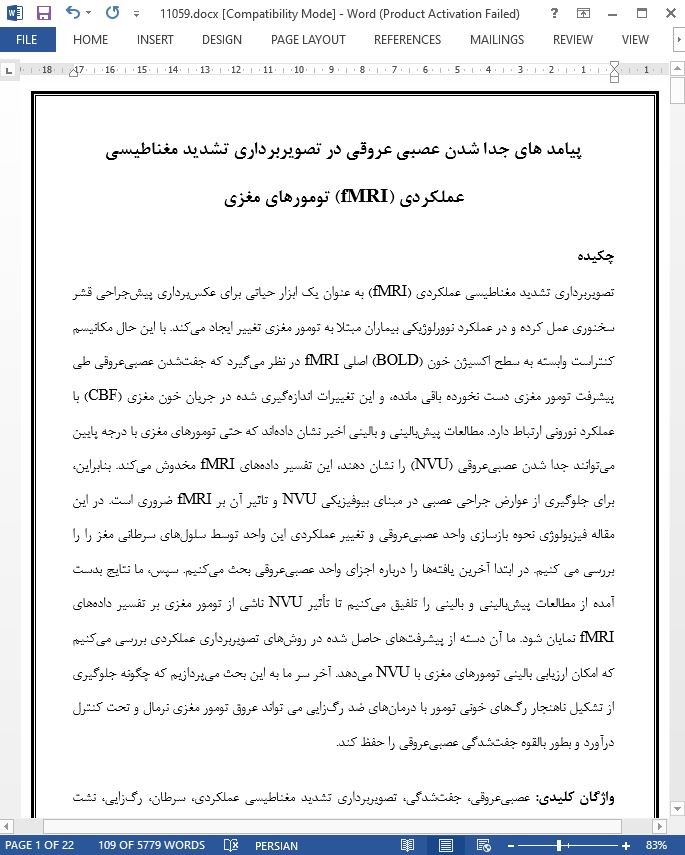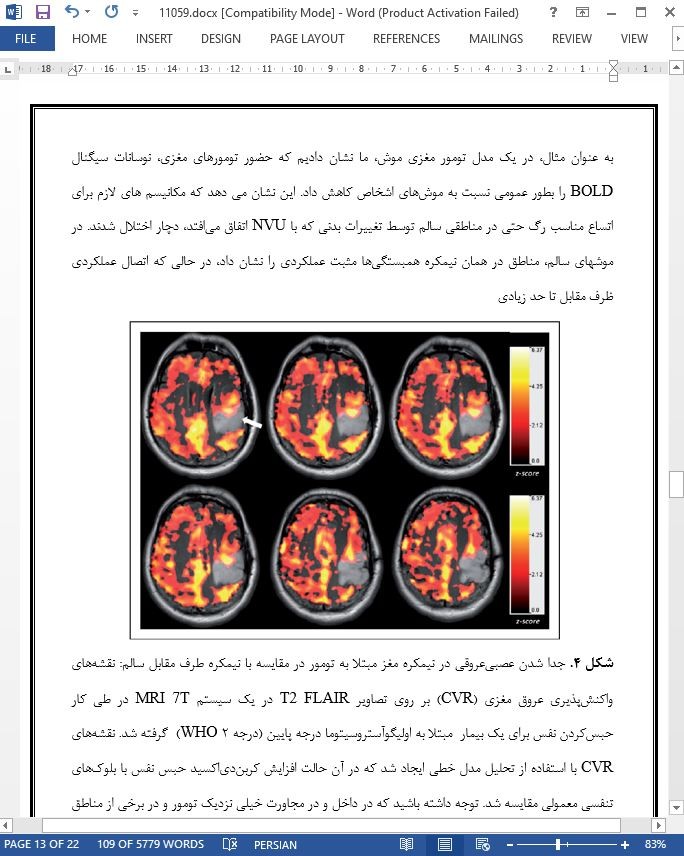
پیامدهای جدا شدن عصبی عروقی در تصویربرداری تشدید مغناطیسی عملکردی (fMRI) تومورهای مغزی
چکیده
تصویربرداری تشدید مغناطیسی عملکردی (fMRI) به عنوان یک ابزار حیاتی برای عکسبرداری پیشجراحی قشر سخنوری عمل کرده و در عملکرد نوورلوژیکی بیماران مبتلا به تومور مغزی تغییر ایجاد میکند. با این حال مکانیسم کنتراست وابسته به سطح اکسیژن خون (BOLD) اصلی fMRI در نظر میگیرد که جفتشدن عصبیعروقی طی پیشرفت تومور مغزی دست نخورده باقی مانده، و این تغییرات اندازهگیری شده در جریان خون مغزی (CBF) با عملکرد نورونی ارتباط دارد. مطالعات پیشبالینی و بالینی اخیر نشان دادهاند که حتی تومورهای مغزی با درجه پایین میتوانند جدا شدن عصبیعروقی (NVU) را نشان دهند، این تفسیر دادههای fMRI مخدوش میکند. بنابراین، برای جلوگیری از عوارض جراحی عصبی در مبنای بیوفیزیکی NVU و تاثیر آن بر fMRI ضروری است. در این مقاله فیزیولوژی نحوه بازسازی واحد عصبیعروقی و تغییر عملکردی این واحد توسط سلولهای سرطانی مغز را را بررسی می کنیم. در ابتدا آخرین یافتهها را درباره اجزای واحد عصبیعروقی بحث میکنیم. سپس، ما نتایج بدست آمده از مطالعات پیشبالینی و بالینی را تلفیق میکنیم تا تأثیر NVU ناشی از تومور مغزی بر تفسیر دادههای fMRI نمایان شود. ما آن دسته از پیشرفتهای حاصل شده در روشهای تصویربرداری عملکردی بررسی میکنیم که امکان ارزیابی بالینی تومورهای مغزی با NVU میدهد. آخر سر ما به این بحث میپردازیم که چگونه جلوگیری از تشکیل ناهنجار رگهای خونی تومور با درمانهای ضد رگزایی می تواند عروق تومور مغزی نرمال و تحت کنترل درآورد و بطور بالقوه جفتشدگی عصبیعروقی را حفظ کند.
جفتشدگی عصبیعروقی ارتباط بین تحریک عصبی و تغییرات همزمان در جریان خون مغزی به منظور فراهم کردن تقاضاهای متغیر انرژی است. این رابطه اساس مکانیسم کنتراست وابسته به سطح اکسیژن خون (BOLD) تشکیل میدهد و این مکانیسم زمینه اصلی تصویربرداری تشدید مغناطیسی عملکردی (fMRI) مغز است. با این حال، سیگنال BOLD کاملا با پتانسیلهای عمل نورونی ارتباط ندارد. سیگنال BOLD ترکیبی از چندین پدیده شامل تغییرات جریان خون مغزی (CBF)، حجم خون مغزی (CBV) و میزان متابولیسم مغزی برای مصرف اکسیژن (CMRO2) است. با این وجود، این جفتشدگی عصبیعروقی است که fMRI قادر به بررسی و ترسیم عملکرد مغز در بیماران کرده است.
نتیجهگیری
گلیوما باعث ایجاد درجات متفاوتی از اختلال در بخش عصبیعروقی متشکل از آستروسیتها، پریسیتهای و سلولهای اندوتلیال میشود. این اختلالات باعث اختلال در جفتشدگی عصبیعروقی میشوند و میتواند به علت عدم پاسخ عروقی و ناتوانایی در تأمین متابولیتها و اکسیژن به جمعیتهای عصبی فعال، منجر به سمیت تحریک بیش از حد سریعتر میشود. هیپوکسی ناشی از مرگومیر سلولهای تومور در نهایت منجر به فعال کردن زنجیرهای از وقایع می شود که به رشد رگزایی و تشکیل عروق خونی متناسب با رشد تومور منجر میشود. تغییر به فنوتیپ کوپشنی نیز میتواند در بیماران رخ دهد، که در آن سلولهای گلیوما تون عروق میزبان را تحت کنترل خود در میآورند.
Abstract
Functional magnetic resonance imaging (fMRI) serves as a critical tool for presurgical mapping of eloquent cortex and changes in neurological function in patients diagnosed with brain tumors. However, the blood-oxygen-level-dependent (BOLD) contrast mechanism underlying fMRI assumes that neurovascular coupling remains intact during brain tumor progression, and that measured changes in cerebral blood flow (CBF) are correlated with neuronal function. Recent preclinical and clinical studies have demonstrated that even low-grade brain tumors can exhibit neurovascular uncoupling (NVU), which can confound interpretation of fMRI data. Therefore, to avoid neurosurgical complications, it is crucial to understand the biophysical basis of NVU and its impact on fMRI. Here we review the physiology of the neurovascular unit, how it is remodeled, and functionally altered by brain cancer cells. We first discuss the latest findings about the components of the neurovascular unit. Next, we synthesize results from preclinical and clinical studies to illustrate how brain tumor induced NVU affects fMRI data interpretation. We examine advances in functional imaging methods that permit the clinical evaluation of brain tumors with NVU. Finally, we discuss how the suppression of anomalous tumor blood vessel formation with antiangiogenic therapies can ‘‘normalize’’ the brain tumor vasculature, and potentially restore neurovascular coupling.
Neurovascular coupling is the relationship between neural firing and concomitant changes in cerebral blood flow to accommodate changing energy demands.1,2 This relationship constitutes the basis of the blood-oxygen-level-dependent (BOLD) contrast mechanism that underlies functional magnetic resonance imaging (fMRI) of the brain. However, the BOLD signal is not perfectly correlated with neuronal action potentials. The BOLD signal is a mixture of several phenomena including changes in cerebral blood flow (CBF), cerebral blood volume (CBV), and the cerebral metabolic rate for oxygen consumption (CMRO2).3 Nonetheless, it is this neurovascular coupling that has made fMRI the workhorse for interrogating and mapping brain function in patients.4
Conclusion
Gliomas result in varying degrees of perturbation to the neurovascular unit composed of astrocytes, pericytes, and endothelial cells. These disruptions impair neurovascular coupling and can lead to faster excitotoxicity due to the lack of vascular response and an inability to supply metabolites and oxygen to active neuronal populations. The resulting hypoxia in conjunction with tumor cell death eventually triggers a cascade of events that leads to angiogenic growth and poorly formed vasculature to support tumor growth. A shift to the co-optive phenotype, in which glioma cells take over control of host vascular tone, can also occur in patients.
چکیده
واحد عصبیعروقی در هموستازی
عروق تومورهای مغزی
تومورهای مغزی واحد عصبیعروقی را تغییر میدهند
fMRI تومورهای مغزی
پیامدهای استفاده از fMRI به عنوان یک نشانگر زیستی از پیشرفت GBM
نتیجهگیری
Abstract
The neurovascular unit in homeostasis
The vasculature of brain tumors
Brain tumors alter the neurovascular unit
fMRI of brain tumors
Implications for the use of fMRI as a biomarker of GBM progression
Conclusion
- اصل مقاله انگلیسی با فرمت ورد (word) با قابلیت ویرایش
- ترجمه فارسی مقاله با فرمت ورد (word) با قابلیت ویرایش، بدون آرم سایت ای ترجمه
- ترجمه فارسی مقاله با فرمت pdf، بدون آرم سایت ای ترجمه



